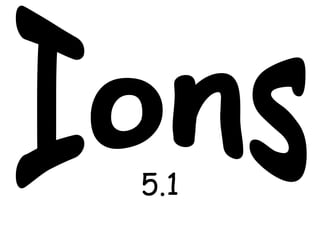Recommended
More Related Content
What's hot (20)
Types Of Chemical Bonds- Ionic Bond,Covalent Bonds,Coordinate Bonds, Basic In...

Types Of Chemical Bonds- Ionic Bond,Covalent Bonds,Coordinate Bonds, Basic In...
Viewers also liked
Viewers also liked (9)
Similar to 5.1 ion formation a groups
Similar to 5.1 ion formation a groups (20)
More from ZB Chemistry
More from ZB Chemistry (20)
5.1 ion formation a groups
- 1. 5.1
- 2. Ions • When atoms are in their pure form, they are neutral. • Neutral atoms can become charged by: – losing electrons – gaining electrons • When they do this they become IONS.
- 3. • Atoms become ions by obeying the octet rule. – All atoms want a full outer shell. – A full outer shell = 8 electrons Octet Rule
- 4. The elements are arranged in groups
- 5. All elements want 8 e- in the valence shell to be stable. Group # # of valence electrons electrons lost or gained Ion Charge
- 7. Ionic Charge
- 9. Ionic charge
- 10. Naming Ions • Positive ions are Cations • Use the name of the element. • Negative ions are Anions • Use the root of the element, drop ending and add – ”ide”.K+1 Ca+2 Al+3 Potassium ion Calcium ion Aluminum ion S-2 O-2 Br-1 N-3 Sulfide ion Oxide ion Bromide ion Nitride ion
- 11. Homework • READ: pages 158-165 –Be sure you understand the connection between orbitals and valence electrons! • Do: p.165 1-13

